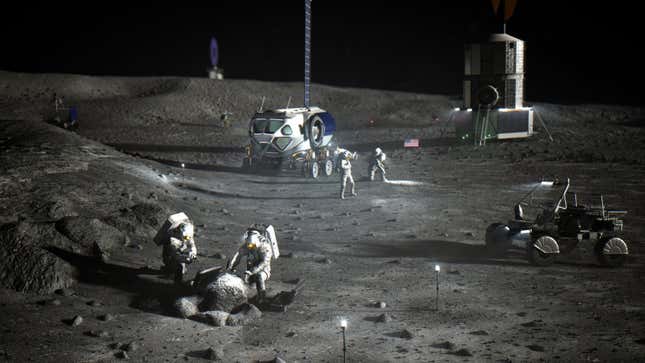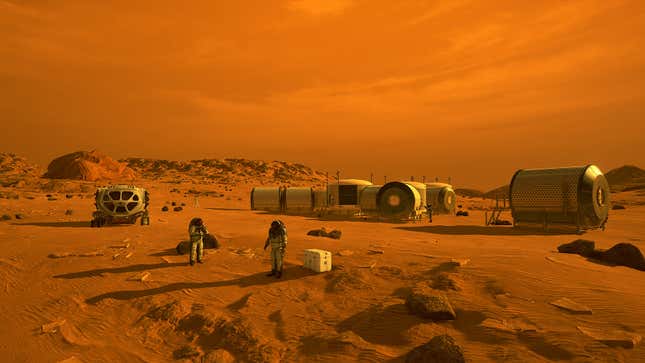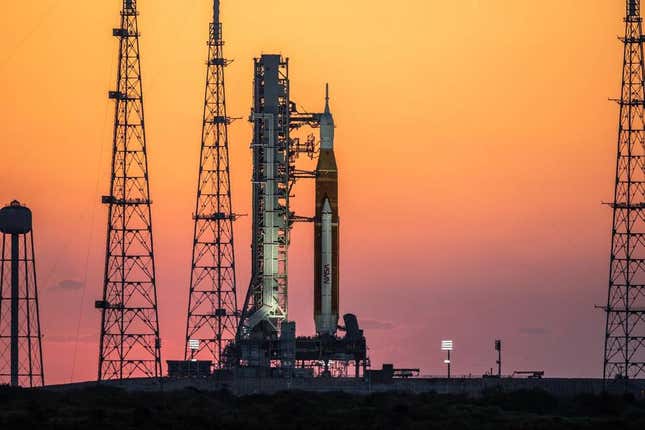NASA’s plodding, iterative approach to its Artemis program gives the distinct impression that it has somehow forgotten how to land humans on the Moon. A closer inspection uncovers the many reasons—whether justified or not—for why it’s taking NASA so long to return boots to those vaunted lunar grounds.
When Apollo 17 astronauts Eugene Cernan, Ronald Evans, and Harrison Schmitt said goodbye to the Moon in December 1972, no one would have guessed that at least 50 years would go by before the next set of humans would return. The closing Apollo mission ended a frenetic period of scientific and technological advancement, an era sparked by the famous “space race” speech given by President John F. Kennedy in 1962.
That’s not to say NASA stood idle during the post-Apollo era. Space exploration continued in different forms, with probes launched to the outer solar system, space stations built in low Earth orbit, Space Shuttles ferrying astronauts to space, and rovers sent to Mars, among many other incredible achievements. As for putting astronauts back on the Moon, not so much.
NASA is seeking to change this through its ambitious Artemis program, which kicked off in spectacular fashion last year with the debut of its Space Launch System (SLS) megarocket. Blasting off with 8.8 million pounds of thrust, SLS sent an uncrewed Orion capsule on a 1.4-million-mile journey around the Moon and back.
The inaugural mission sets the stage for Artemis 2, a crewed journey around the Moon and back, and Artemis 3, a mission to land a man and a woman on the Moon in 2025. It’s an achingly slow pace, but the situation is even worse than that. Artemis 4 won’t happen until 2028 at the earliest, which is quite the gap between missions. Artemis 5 through 7 are expected to transpire yearly starting in 2029.
For NASA, it’s one important step at a time, but to casual observers it seems as though NASA has opted to reinvent the wheel. Why can’t NASA more quickly manage a feat it nailed six times a half-century ago? It should be a piece of cake to do so now, no?
It’s a fair point, but the U.S. is now far removed from Cold War mentalities, and it’s got vastly different priorities, both internationally, domestically, and even environmentally. The space agency is unquestioningly limited by what Congress will allow, but when it comes to the slow pace of Artemis, there’s something else to consider, and that’s NASA’s desire to maintain a human presence around the Moon for the long term. And, crucially, much of Artemis is predicated on an even greater ambition: landing humans on Mars.
To the Moon—on a shoestring
The pace of Artemis’s development is greatly constrained by budget, and NASA now longer has access to the kind of money it had during the Cold War.
“All you need to do is look at the NASA budget as a percent of GDP under Kennedy and today, and it is easy to understand why we are not making the giant leaps of the Apollo era,” explained Michelle Hanlon, co-director of the Center for Air and Space Law at the University of Mississippi. It wasn’t difficult to rally the nation given the Cold War climate and “what certainly looked like Soviet superiority in space,” but “once the challenge was met the national mood changed,” Hanlon wrote in an email, adding that more people watched a rerun of I Love Lucy than the Apollo 17 broadcasts in 1972.

President Richard Nixon was ultimately responsible for downscaling NASA’s lunar ambitions. The intense cost of Apollo made it unsustainable and, as a politically driven “flags and footsteps” endeavor, the program lost its luster once the U.S. beat the Soviet Union to the prize, according to Jack Burns, a professor in the physics department at the University of Colorado-Boulder. It didn’t help that Nixon “hated the Kennedys,” Burns explained during our video call, noting Kennedy’s connection to Apollo.
“Apollo used an enormous amount of resources—5% of the federal budget went into NASA in the mid 1960s, whereas today it’s less than four-tenths of 1%—and we’re still going to the Moon and we’re still planning on going to Mars,” said Burns. “That’s an order of magnitude less cost to do this,” he said. NASA may seem a monumental agency, with its proposed budget of $27 billion for next year, but that’s roughly half of what President Biden wants to give the National Institutes of Health in 2024.
The ongoing war in Vietnam compounded the budgetary situation even further, and “don’t forget that there were protests of the Apollo program—Whitey on the Moon anyone?—with activists wondering how we could rationalize literally taking food out of the mouths of poverty-stricken children to support putting a human on the Moon,” said Hanlon.
With a shrunken budget and the Moon landing checked off the to-do list, NASA moved on to more modest celestial pastures. Five decades later, the space agency is once again setting its sights on the Moon, but with yearly budgets that pale in comparison to the Apollo era. Christopher Impey, a professor of astronomy at the University of Arizona, says NASA is having to spread out the funding it does receive from Congress.
“They have Earth-observing scientific programs, they have propulsion development,” and they’re “doing a lot of ambitious planetary science missions,” Impey explained during a video call. NASA has “a lot of things that they have to squeeze into that budget,” so “shoehorning something like going back to the Moon” is “always a challenge and it’s always going to take longer than you want,” he said.
At the same time, the energy and urgency of Apollo is “probably not going to be repeated because we have bigger fish to fry,” said Impey. “We have a planet that’s going down the toilet, and we have a lot of issues that America is concerned about and distracted by, and is going to cost money to fix.” The U.S. approach to space has moved away from the “we could do anything” mentality of the 1950s and 1960s, Impey said, and “we’re never going to be in that space anymore—the bloom is off the rose.”
Relatedly, the slowness in returning to the Moon is also the result of the average person either not caring for space or not understanding the need or desire to go back to the Moon, according to Impey. “We have all these problems on Earth, and so I think a large chunk of the public is just deeply skeptical that this is the thing we should do even before putting a price tag on it.”
‘We are going forward to the Moon to stay’
The Apollo missions were relatively simple in nature: Land pairs of humans on the surface, have them hang out for a bit, and get them the hell back home in one piece. Rinse and repeat six times. A key difference with Artemis is that NASA, in addition to returning astronauts to the Moon, is seeking to do so in a sustainable way and to create systems, technology, and infrastructure that will enable our long-term presence in the lunar environment. That presents an important challenge and another reason why Artemis is taking so long to unfold.
“Returning to the Moon seems so hard because it is hard,” Jessica West, a senior researcher at Project Ploughshares, explained in an email. “Especially to do it in a way that is safe and can be sustained into the future.”

“The whole program is fundamentally different from Apollo—this is not Apollo,” said Burns.
NASA and its commercial and international partners have big plans. The rationale for reaching the Moon has fundamentally changed; instead of it being a race to the Moon, it’s an effort to expand our reach into space, whereby we would use the Moon to extract important resources and perform important science. “In many ways, we are back in a race,” said Hanlon. “But this is not just about prestige—it’s about resources.” As she points out: “Whoever gets there first will get both bragging rights and the pick of where to go. You can imagine the implications.”
Competition aside, Hanlon says the time has come for humans to work more seriously in exploring and using the vast resources space has to offer. “This starts with the Moon, our stalwart and nearest neighbor,” she said. “The Moon will be the testing ground for future deeper forays into space. This will be a very long process that will proceed in baby steps.”
“We couldn’t have thought of that in the 60s—the mining of water and other materials, and preparing to go to Mars,” said Burns. “The idea that we could have gone to Mars right after Apollo was pure fantasy.”
Entirely new sets of technologies
For sure—there’s no way NASA could have attempted an Artemis-like plan in the immediate post-Apollo era. For Artemis, NASA and its international partners are planning to build the first lunar space station, known as Gateway. There’s also a desire for sustainable infrastructure, whether it be nuclear reactors on the Moon or swarms of lunar satellites to ensure constant contact with Earth.
With its focus on the southern polar region, Artemis requires an entirely new Moon suit, a prototype of which is currently in development. Other requirements include at least two human landing systems, a lunar terrain vehicle, a pressurized rover, various support satellites, fission surface power, prototypes to test water and oxygen production, and surface habitats. NASA also wants to build a full-fledged base camp on the Moon for continual occupation.

Much of these technologies will be rolled out as the Artemis missions mature, but many of the elements need to be designed from scratch. That’s going to take time. Lots of time.
“This isn’t about reinventing the wheel: the whole mission has been reinvented from a Moonshot to the creation of a permanent human presence on the Moon and beyond serviced by a commercial economy,” said West. “The question is no longer how to get there but how to stay, and how to do it in a way that is environmentally safe, economically sustainable,” and in a way that “benefits people today as well as future generations.” To which she added: “This type of mission is about not just technology but also international cooperation and governance.”
West brings up a good point. NASA leaned on the commercial sector during Apollo, but this reliance is now at an entirely new level. The space agency finally has the confidence to outsource its projects to the private realm, something that remains a learning experience for NASA. SpaceX, for example, needs to provide NASA with those aforementioned human landing systems, but, not wanting to rely on a single vendor, NASA wants a second option from a different company. This decision was likely influenced by NASA’s experience in outsourcing a commercial crew vehicle for shuttling astronauts to the International Space Station, with SpaceX’s Crew Dragon now in operation and Boeing’s Starliner still in the development stage after years of seemingly endless frustration.
That NASA is relying more heavily on commercial partnerships is ultimately a good thing, as it fosters innovation and brings down costs. That said, NASA probably should’ve adopted this strategy more than a decade ago when deciding to go ahead with SLS—a fully expendable rocket that will cost the agency some $4.1 billion for each launch. Those staggering costs alone, it’s fair to say, can’t possibly be pushing Artemis along in terms of pace.
A springboard to Mars
Another key reason for why Artemis is taking so long to unfold is that the program is serving double duty as a precursor mission to Mars. Virtually everything that’s being developed for Artemis needs to be leveraged for the first crewed missions to the Red Planet.

NASA and its partners will learn valuable lessons as they build and work on the Moon. And even though the environment may be somewhat different, it’s still common enough to Mars that we’ll find value in those lessons before we’re ready to blast off for the Red Planet, according to Burns.
“That’s gonna take some time,” Burns added, “And that’s why I don’t see us being on Mars in the 2030s or the 2040s. I think it’s going to be more like the 2050s when we can really do this.” Another potential barrier will be the tremendous costs involved with a Mars mission. “Hells bells, man, if we can’t afford to go to the Moon, how in God’s name can we go to Mars, because Mars is going to be a significant fraction of a trillion dollars.”
An aversion to taking risks
On January 27, 1967, three NASA astronauts—Gus Grissom, Edward White, and Roger Chaffee—lost their lives while preparing for the inaugural Apollo mission. Years later, a total of 14 astronauts were killed during two catastrophic Shuttle missions. These traumatic episodes and the resulting institutional shockwaves contributed to a culture at NASA that is now, for better or worse, profoundly averse to taking risks.
The very first steps taken back to the Moon were done to develop the Orion spacecraft and SLS. The jumbo rocket finally launched in November 2022 after years of delays that served to frustrate a public wanting to see NASA return to its former glory. The delay with launching SLS also served to confuse the public, many of whom still remember the steady launch cadence of Saturn V rockets during Apollo.

As for the succession of developmental delays and launch scrubs, Burns says it’s important to not forget the history of Apollo, which experienced similar setbacks. “This is not unusual when you’ve got a new rocket,” he said. SLS is “not the Saturn V and it’s not the Space Shuttle. It really is a brand new rocket, and NASA could not afford to fail, because a failure of Artemis 1 would have been beyond disaster. It really would have set back the entire program to the Moon, so they were cautious, and one might argue overly cautious,” Burns explained.
If NASA wanted to shuttle a crew to the Moon as quickly as possible and not have to worry about potentially killing those astronauts in the process, it could accomplish that feat by next Tuesday. But dead astronauts are a bad look, especially for a federally funded agency, requiring NASA to exercise caution and make safety a perennial priority. And while NASA was willing to take risks during the Cold War race to the Moon, it cannot do so now, given the almost complete absence of urgency.
Safety takes time, of course, and a lot of money, but being too cautious can stunt development. “NASA has become a very risk averse organization, and that’s troublesome when you’re trying to do something as difficult as the space program,” Burns said. SpaceX, with its risk tolerance, can crash umpteen uncrewed prototypes en route to creating operational rockets, but NASA, with Congress looking over its shoulder, simply does not have that luxury. As Burns points out, however, NASA is poised to embark on some incredibly risky missions to the Moon, so it’s going to have to yield a little bit when it comes to navigating hazards.
It’s not that we want to tolerate the loss of human life, Burns said, it’s that NASA needs to find that “sweet spot between being careless and making sure that we preserve our instruments and our astronauts, and keep them safe,” he said. “I would argue that we’re not there. We don’t understand that, and this is one of the biggest things that we need to be able to figure out over the next decade or two, because we will have to overcome some loss of life. No one likes to talk about it, and that’s understandable.” NASA, Congress, and even the general public, Burns argues, must find a way to adjust to that reality.
Impey shared a near identical assessment. NASA, through its risk aversion, moves “slowly and very methodically,” he said, as they’re “unwilling to have an astronaut die in space.” But “astronauts have almost never died in space—it’s actually an incredibly rare thing,” Impey explained, adding that “it’s certainly more dangerous to go base jumping that it is to go into Earth orbit, but that’s not what people think when they see a rocket blowing up and teachers and civilians dying.”
The Moon’s not going anywhere
“We are perched on an incredible threshold today,” said Hanlon. “We are not going to the Moon to prove we can do it, we are going to the Moon to learn how to live and work in space so that we can continue to explore our universe.”
Truly, our quest to be an interplanetary species is arguably the most extreme venture we’ve ever attempted, and it would be foolish to think we can accomplish this quickly. Sure, NASA has problems when it comes to budgets or how it handles risks, but it has a history of ultimately getting things done. And now, with its newfound reliance on the commercial sector, NASA will have to let them lead the way to new and innovative ideas.
We’ll get back to the Moon eventually, and that’s the key thing to remember. It’s easy to get fixated on timelines and blown delivery dates, but space continues to be hard, especially now as we push the envelope to new extremes.
Want to know more about humanity’s next giant leap in space? Check out our full coverage of NASA’s Artemis Moon program, the new Space Launch System (SLS) rocket and Orion spacecraft, the recently concluded Artemis 1 mission around the Moon, the four-person Artemis 2 crew, NASA and Axiom’s Artemis Moon suit, and the upcoming lunar Gateway space station. And for more spaceflight in your life, follow us on Twitter and bookmark Gizmodo’s dedicated Spaceflight page.





